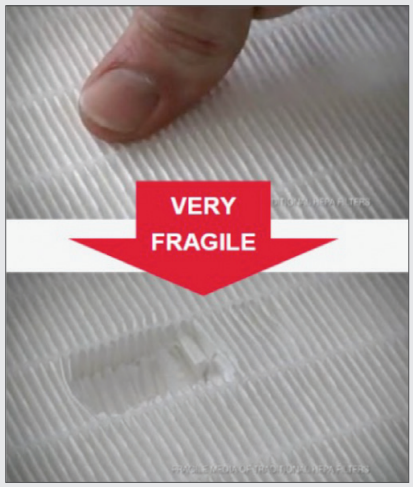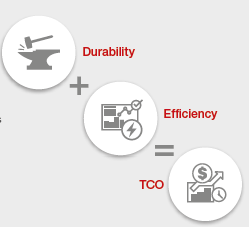MEGAcel® HEPA Filtration

Understanding the Media Options Available to You
HEPA and ULPA filters made with microglass media have stood the test of time for over 75 years. However, aside from the development of “low boron” microglass media for the microelectronics industry, the technology has seen very little innovation since its inception. While its filtration performance has been proven throughout its long history, unfortunately so has its fragility. Despite its well documented filtration performance, the delicate nature of glass fiber media continues to present a potential risk for damage that should be considered when selecting the ideal media for a given application.
Conversely, membrane media technologies have seen and experienced continuous innovation and adoption across many industries and applications over the past 30 years. In the early 1990’s, increased demand from the booming microelectronics industry for HEPA and ULPA grade air filters with reduced offgassing properties and improved energy efficiency created an opportunity for innovation in HEPA and ULPA grade medias. Within that same time period, Daikin Industries discovered an ultrafine fiber structure that would enable a revolutionary change in air filter membrane media development.
Proven Alternatives to Glass Fiber Media
The development of Daikin’s unique ultrafine fiber ePTFE membrane media offered an alternative option to glass fiber filters for the microelectronics industry that provided the lowest offgassing properties, lowest energy consumption, and far superior tensile strength and durability. This technological advancement enabled the industry to dramat¬ically reduce operating costs, while also improving production yield. Since that time, ePTFE media has become the media of choice for the microelectronics industry.
Expanded Portfolio of Membrane Technologies
Membrane technologies have evolved since the discovery of the u ltrafine fibers by Daikin Industries in 1988. The main benefits remain the same: excellent pressure drop, ultra-low emissions, and superior durability when compared to glass fiber media. However, the portfolio of available media types for specific applications has expanded.
Enter Fluororesin Membrane
Expanded fluororesin membrane, or eFRM, represents the next generation of membrane media technology, designed specifically for applications where high concentrations of oil-based test aerosols (i.e., PAO) and fine particulate (i.e., hydrocarbons) are present. Since 2012, this unique recipe of ultra-fine membrane layers and support structures has delivered the same low resistance and durability of first-generation membrane media in these demanding environments.
Media Resilience Comparison
AAF International HEPA/ULPA filters utilizing Daikin’s ultra-fine fiber membrane media technology are the product of choice in the most demanding environments. Wet laid glass fiber media is delicate and vulnerable to varying degrees of breakage, ranging from pinhole leaks to irreparable damage.

Selecting the Right HEPA/ULPA Filter
Key Risk Based Considerations:
Modes of HEPA/ULPA Filter Failure
Now that we understand the critical role of media selection in the choice of HEPA/ULPA filters for a given application, it’s important to also review some of the in-situ risk that the filter will be confronted with in the clean space.
HANDLING
| |
TESTING & CERTIFICATION
| |
CLEANING
| |
UNINTENDED CONTACT
|
Comparing Glass Fiber and Membrane Media Options
The risks listed above can be mitigated by the use of durable PTFE or FRM membrane-based HEPA/ULPA filters. The table below shows a comparison of physical properties of ePTFE, eFRM, and glass fiber HEPA filters for consideration when durability and reliability are key concerns.

Summary of Considerations for HEPA/ULPA Filter Selection
This product guide contains multiple product options and configurations for your review and selection. Below is a helpful checklist of items to consider as you make your final selection.

What to look for in HEPA/ULPA Filters
Media Integrity
- Highest level of mechanical strength for resistance to damage, leaking, or failure
- Chemically inert, which reduces media degradation in highly corrosive environments
- Hydrophobic (water resistant)
Economy and Testing
- Lowest available pressure drop to reduce energy consumption and changeout cycles
- Lowest off-gassing of chemical components to minimize risk of contamination
- Ability to perform local field testing per standards for your environment
Total Cost of Ownership
- Clearly quantify all potential operational risks associated with your filter selection
- Invest in technology that improves operational performance and reduces the effort required for maintenance and repair
- Partner with a supplier that can provide professional guidance and a fully integrated system solution
Comparison of HEPA Filter by Media Type
eFRM Filters | Microglass Filters | PTFE Filters | Polymeric Filters | |
| Solid Particle Loading | * | * | * | * |
| Liquid Particle Loading | * | * | Poor | * |
| Chemical Compatibility | * | * | * | Poor |
| Efficiency Stability | * | * | * | Poor |
| Durability | Robust | Frigile | Robust | Robust |
| Pressure Drop | Lowest | Higher | Lowest | Good |
| Lifetime | * | * | * | N/A |
| Years in Service | 8+ | 70+ | 20+ | N/A |
| Units Fielded | Tens of Thousands | Milions | Milions | N/A |
| Fielded Location | Global | Global | Global | N/A |
Unsurpassed Performance
The leading HEPA filtration technology for life science industries, eFRM media offers superior durability at the lowest airflow resistance. MEGAcel filters virtually eliminate the risks of media damage and degradation while minimizing operational expenses and interruptions. With tens of thousands of installed units worldwide, MEGAcel filters have exceeded the most stringent industry performance requirements since 2012.
MEGAcel is the ideal HEPA media technology to ensure peace of mind at the lowest total cost of ownership.
MEGAcel is the ideal HEPA media technology to ensure peace of mind at the lowest total cost of ownership.

Understanding the Media Options Available to You
HEPA and ULPA filters made with microglass media have stood the test of time for over 75 years. However, aside from the development of “low boron” microglass media for the microelectronics industry, the technology has seen very little innovation since its inception. While its filtration performance has been proven throughout its long history, unfortunately so has its fragility. Despite its well documented filtration performance, the delicate nature of glass fiber media continues to present a potential risk for damage that should be considered when selecting the ideal media for a given application.
Conversely, membrane media technologies have seen and experienced continuous innovation and adoption across many industries and applications over the past 30 years. In the early 1990’s, increased demand from the booming microelectronics industry for HEPA and ULPA grade air filters with reduced offgassing properties and improved energy efficiency created an opportunity for innovation in HEPA and ULPA grade medias. Within that same time period, Daikin Industries discovered an ultrafine fiber structure that would enable a revolutionary change in air filter membrane media development.
Proven Alternatives to Glass Fiber Media
The development of Daikin’s unique ultrafine fiber ePTFE membrane media offered an alternative option to glass fiber filters for the microelectronics industry that provided the lowest offgassing properties, lowest energy consumption, and far superior tensile strength and durability. This technological advancement enabled the industry to dramat¬ically reduce operating costs, while also improving production yield. Since that time, ePTFE media has become the media of choice for the microelectronics industry.
Expanded Portfolio of Membrane Technologies
Membrane technologies have evolved since the discovery of the u ltrafine fibers by Daikin Industries in 1988. The main benefits remain the same: excellent pressure drop, ultra-low emissions, and superior durability when compared to glass fiber media. However, the portfolio of available media types for specific applications has expanded.
Enter Fluororesin Membrane
Expanded fluororesin membrane, or eFRM, represents the next generation of membrane media technology, designed specifically for applications where high concentrations of oil-based test aerosols (i.e., PAO) and fine particulate (i.e., hydrocarbons) are present. Since 2012, this unique recipe of ultra-fine membrane layers and support structures has delivered the same low resistance and durability of first-generation membrane media in these demanding environments.
Media Resilience Comparison
AAF International HEPA/ULPA filters utilizing Daikin’s ultra-fine fiber membrane media technology are the product of choice in the most demanding environments. Wet laid glass fiber media is delicate and vulnerable to varying degrees of breakage, ranging from pinhole leaks to irreparable damage.

Selecting the Right HEPA/ULPA Filter
Key Risk Based Considerations:
Modes of HEPA/ULPA Filter Failure
Now that we understand the critical role of media selection in the choice of HEPA/ULPA filters for a given application, it’s important to also review some of the in-situ risk that the filter will be confronted with in the clean space.
HANDLING
| |
TESTING & CERTIFICATION
| |
CLEANING
| |
UNINTENDED CONTACT
|
Comparing Glass Fiber and Membrane Media Options
The risks listed above can be mitigated by the use of durable PTFE or FRM membrane-based HEPA/ULPA filters. The table below shows a comparison of physical properties of ePTFE, eFRM, and glass fiber HEPA filters for consideration when durability and reliability are key concerns.

Summary of Considerations for HEPA/ULPA Filter Selection
This product guide contains multiple product options and configurations for your review and selection. Below is a helpful checklist of items to consider as you make your final selection.

What to look for in HEPA/ULPA Filters
Media Integrity
- Highest level of mechanical strength for resistance to damage, leaking, or failure
- Chemically inert, which reduces media degradation in highly corrosive environments
- Hydrophobic (water resistant)
Economy and Testing
- Lowest available pressure drop to reduce energy consumption and changeout cycles
- Lowest off-gassing of chemical components to minimize risk of contamination
- Ability to perform local field testing per standards for your environment
Total Cost of Ownership
- Clearly quantify all potential operational risks associated with your filter selection
- Invest in technology that improves operational performance and reduces the effort required for maintenance and repair
- Partner with a supplier that can provide professional guidance and a fully integrated system solution
Comparison of HEPA Filter by Media Type
eFRM Filters | Microglass Filters | PTFE Filters | Polymeric Filters | |
| Solid Particle Loading | * | * | * | * |
| Liquid Particle Loading | * | * | Poor | * |
| Chemical Compatibility | * | * | * | Poor |
| Efficiency Stability | * | * | * | Poor |
| Durability | Robust | Frigile | Robust | Robust |
| Pressure Drop | Lowest | Higher | Lowest | Good |
| Lifetime | * | * | * | N/A |
| Years in Service | 8+ | 70+ | 20+ | N/A |
| Units Fielded | Tens of Thousands | Milions | Milions | N/A |
| Fielded Location | Global | Global | Global | N/A |
Unsurpassed Performance
The leading HEPA filtration technology for life science industries, eFRM media offers superior durability at the lowest airflow resistance. MEGAcel filters virtually eliminate the risks of media damage and degradation while minimizing operational expenses and interruptions. With tens of thousands of installed units worldwide, MEGAcel filters have exceeded the most stringent industry performance requirements since 2012.
MEGAcel is the ideal HEPA media technology to ensure peace of mind at the lowest total cost of ownership.
MEGAcel is the ideal HEPA media technology to ensure peace of mind at the lowest total cost of ownership.

 FHK Polska
FHK Polska PureMedion Kft.
PureMedion Kft. Elfa spol. s r. o.
Elfa spol. s r. o. Ecotip d.o.o.
Ecotip d.o.o.

